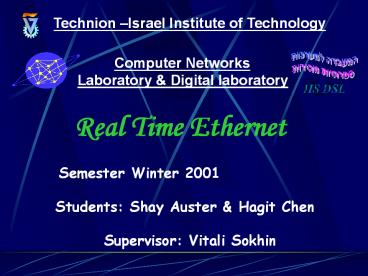Technion - PowerPoint PPT Presentation
1 / 40
Title: Technion
1
Technion Israel Institute of Technology
Computer Networks Laboratory Digital laboratory
Real Time Ethernet
Semester Winter 2001
Students Shay Auster Hagit Chen
Supervisor Vitali Sokhin
2
RTE - Preview
- An Ethernet protocol for Real-Time.
- Analytic analisys of estimated performance.
- Design an adiqute simulation.
- Run various scenarios in simulation.
- Conclusions.
3
Abstract
- Real Time Streaming requires a bound on the time
of which a packet is created until it reaches its
destination. - IEEE 802.3u protocol does not support this
requirment. - Hence, a Real Time Ethernet protocol needs to be
defined.
4
RTE Protocol - Overview
- Combine Ethernet and RTE transmisions on the same
network. - On the same Lan All RTE stations support the
same application. - In order to coordinate transmisions between RTE
stations A mechanism to serializes
transmisions.
5
- Serializations of RTE transmitsions
- Head and Tail are required for the Handshaking -
a mechanism which serealizes RTE transmisions.
6
RTE frame
Ethernet frame bounded between a head and a tail
- Head
- Clean channel for RT transmisions.
- Notify all other RT stations on RTE transmision
status.
- Tail
- Notify all other RT stations on RTE transmisions
status.
7
Overview cont.
- Two possible situations in channel
- RTE transmision in channel A new RTE station
join the end of the chain. - No RTE transmision The RTE station generates a
new chain. - A RTE chain transmision in channel
- RTE station interupt at the end of the chain no
handshaking at 1st time. - Part of chain - handshaking from next time.
8
Final ResultsAnalysis
9
Ethernet always transmits
- Basic Ethernet simulation.
- Stations always have packets to transmit.
10
Ethernet always transmits
- Ethernet simulation results are used as a
reference in analysing RTE simulation results.
11
RTE Always transmits
- Ethernet always transmit.
- RTE According to protocol.
12
RTE always transmits
- A Single RTE Station
- Various number of Ethernet stations
13
RTE always transmits
- Three RTE Station
- Various number of Ethernet stations
14
RTE always transmits
- Five RTE Station
- Various number of Ethernet stations
15
Ethernet The poissonic case
- Poissonic arrival of packets to stations.
- The interval between arrival of packets is
exponential distributed ? poissonic arrival of
packets. - For exponential probability function we used an
inverse distribution function.
16
Ethernet poissonic case
- Ethernet packets arrival rate is poissonic.
- t 1000uSec mue 1
17
Ethernet poissonic case
- Ethernet packets arrival rate is poissonic.
- t 500uSec differnet mue (0.5/1/2)
18
Ethernet poissonic case
- Ethernet packets arrival rate is poissonic.
- Different t (500/1000/2000uSec) mue 1
19
RTE The poissonic case
- Ethernet Poissonic arrival of packets to
stations. - RTE According to protocol.
20
RTE poissonic case
- Ethernet packets arrival rate is poissonic.
- A single RTE station.
- t 1000uSec mue 1
21
RTE poissonic case
- Ethernet packets arrival rate is poissonic.
- Three RTE stations.
- t 1000uSec mue 1
22
RTE poissonic case
- Ethernet packets arrival rate is poissonic.
- Five RTE stations.
- t 1000uSec mue 1
23
RTE poissonic case
- Ethernet packets arrival rate is poissonic.
- Different RTE stations.
- t 1000uSec mue 1
24
Ethernet The On/Off case
- On Always transmits.
- Off Never transmits.
- The on/off intervals are exponentily distributed.
25
Ethernet On/Off case
- 64 Bytes packet.
- Different On/Off data.
26
Ethernet On/Off case
- 256 Bytes packet.
- Different On/Off data.
27
Ethernet On/Off case
- 1024 Bytes packet.
- Different On/Off data.
28
RTE The On/Off case
- Ethernet -
- On Always transmits.
- Off Never transmits.
- RTE According to protocol.
29
RTE On/Off case
- 1024 bytes Ethernet packets.
- A Single RTE station.
- Different On/Off data.
30
RTE On/Off case
- 1024 bytes Ethernet packets.
- Three RTE stations.
- Different On/Off data.
31
RTE On/Off case
- 1024 bytes Ethernet packets.
- Five RTE stations.
- Different On/Off data.
32
Ethernet Stations Wait Time
- Ethernet Allways transmit.
- No RTE.
- Wait time increases with packet size.
33
RTE Stations Wait Time
- Ethernet Allways transmit.
- One RTE station.
- Wait time increases with packet size.
- Wait time increases with number of RTE stations.
34
RTE Stations Wait Time
- Ethernet Allways transmit.
- Three RTE stations.
- Wait time increases with packet size.
- Wait time increases with number of RTE stations.
35
RTE Stations Wait Time
- Ethernet Allways transmit.
- Five RTE stations.
- Wait time increases with packet size.
- Wait time increases with number of RTE stations.
36
RTE - Jitter
- Ethernet Allways transmit.
- Various number of RTE stations.
- Jitter increases with packet size number of RTE
stations.
37
Time to genrate RTE chain
- Ethernet Allways transmit.
- Various number of RTE stations.
- Chain time increases with number of RTE stations.
38
Application example
- Ethernet Allways transmit.
- Various number of RTE stations.
- Application sampeling rate 1.5Mbps.
39
Conclusions
- RTE stations uses a part of the Ethernet channel
? Ethernet stations Efficiency decreases. - The total chanel efficiency increases.
- For Ethernet allways transmit on/off arrival
times we get an immediate reduce of efficiency. - For poisonic arrival of packets we dont get an
immediate reduce of efficiency.
40
Conclusions
- For each arrival pattern channel efficiency
converges to the allways transmits results (for
sufficient number of stations). - More stations (regular/RTE) ? Larger wait time.
- Bigger packets ? Larger wait time.? Larger
Jitter.

